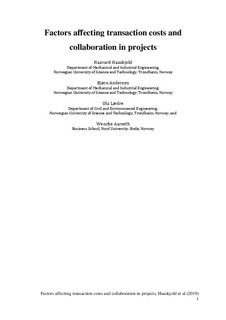| dc.contributor.author | Haaskjold, Haavard | |
| dc.contributor.author | Andersen, Bjørn Sørskot | |
| dc.contributor.author | Lædre, Ola | |
| dc.contributor.author | Aarseth, Wenche | |
| dc.date.accessioned | 2019-12-19T13:12:59Z | |
| dc.date.available | 2019-12-19T13:12:59Z | |
| dc.date.created | 2019-06-27T16:56:43Z | |
| dc.date.issued | 2019 | |
| dc.identifier.citation | International Journal of Managing Projects in Business. 2019, . | nb_NO |
| dc.identifier.issn | 1753-8378 | |
| dc.identifier.uri | http://hdl.handle.net/11250/2634163 | |
| dc.description.abstract | Purpose
Transaction costs in projects can be reduced through improved collaboration between contractors and clients. The purpose of this paper is to respond to the call for further research on the framework suggested by Li et al. (2015) who presented 26 factors that determine project transaction costs. The objective is to empirically test the framework to identify factors that have the greatest influence on project collaboration so that practitioners can prioritize their efforts on the most salient factors that will improve collaboration and reduce transaction costs.
Design/methodology/approach
The paper employed interviews with 38 project practitioners from three different industries in Norway. The respondents had in average 20 years of professional experience.
Findings
The quality of communication, project uncertainty, owner’s organizational efficiency, change orders and trust were the five most frequently found factors that influence both project transaction costs and collaboration level. When the authors compared findings between different industries the authors found that the quality of communication was important for all industries. The owner’s organizational efficiency was also highly important in oil and gas and ICT projects. Trust was particularly important in oil and gas projects while frequency of claims was particularly important in construction projects.
Practical implications
This paper identifies the five most important factors for project practitioners to prioritize in order to reduce transaction costs through improved collaboration.
Originality/value
The paper contributes to the conceptual theory of transaction costs and collaboration as it empirically tests and extends the framework developed by Li et al. (2015). | nb_NO |
| dc.language.iso | eng | nb_NO |
| dc.publisher | Emerald | nb_NO |
| dc.title | Factors affecting transaction costs and collaboration in projects | nb_NO |
| dc.type | Journal article | nb_NO |
| dc.type | Peer reviewed | nb_NO |
| dc.description.version | acceptedVersion | nb_NO |
| dc.source.pagenumber | 34 | nb_NO |
| dc.source.journal | International Journal of Managing Projects in Business | nb_NO |
| dc.identifier.doi | 10.1108/IJMPB-09-2018-0197 | |
| dc.identifier.cristin | 1708426 | |
| dc.description.localcode | © 2019. This is the authors' accepted and refereed manuscript to the article. The final authenticated version is available online at: http://dx.doi.org/10.1108/IJMPB-09-2018-0197 | nb_NO |
| cristin.unitcode | 194,64,92,0 | |
| cristin.unitcode | 194,64,91,0 | |
| cristin.unitname | Institutt for maskinteknikk og produksjon | |
| cristin.unitname | Institutt for bygg- og miljøteknikk | |
| cristin.ispublished | true | |
| cristin.fulltext | original | |
| cristin.fulltext | postprint | |
| cristin.qualitycode | 1 | |
